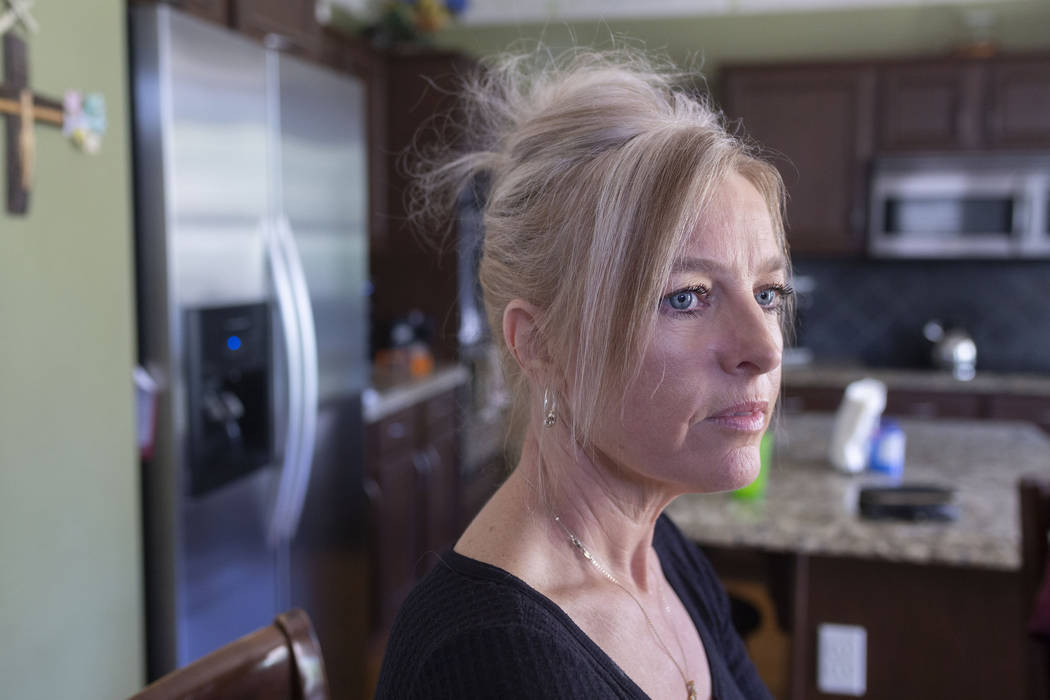Did vaping trigger Henderson teen’s near-fatal lung illness?
Nathan Harrington doesn’t remember the fever and vomiting that prompted his mother to take him to an urgent care center.
He can’t remember the ambulance ride from the center to St. Rose Dominican Hospital, Siena campus, in Henderson. He doesn’t remember his friends crying in his hospital room because they thought he would die, or his mother spending each night at his bedside.
When Nathan, then 19, arrived at the hospital on July 31, doctors at first thought that he’d be back on his feet after a couple of rounds of antibiotics. But he got worse, not better, both his lungs filling with fluid, his kidneys failing and sepsis poisoning his bloodstream.
Doctors had no idea what had made the previously healthy Henderson teenager so sick.
It was Nathan’s 21-year-old brother, Bryan, who first suggested the cause might be vaping.
Mysterious illness
Media reports of a mysterious lung ailment in eight teens in Wisconsin who had used e-cigarettes began to appear around the time of Nathan’s hospitalization. Bryan, who knew that his younger brother vaped, shared the reports with his mother, Katherine Hall.
At first a connection seemed unlikely, but test after test showed no bacterial or viral cause of Nathan’s illness, and doctors were stumped.
The illness soon progressed to acute respiratory distress syndrome, which often leads to death.
Hall said she was told by medical staff, “’People that come in in this condition that are older have, like, a 5 percent chance of making it. But he’s young. He’s got youth on his side.’
“The only hope we had was the youth,” said Hall, who works full time as a cocktail waitress and part time as a registered nurse.
Doctors told her “they had never seen anything like this.”
“The doctors kept saying, ‘This is baffling us. We have no idea what is going on,’” Hall said.
Nathan was put into an induced coma and placed on a ventilator to help him breathe. As August wore on, media reports multiplied about a growing number of cases of a mysterious lung disease that was afflicting people who vaped. Vaping involves puffing on a battery-powered electronic cigarette, which heats nicotine or marijuana products to produce an aerosol.
Hall asked medical staff whether vaping might be at the center of her youngest son’s illness, but they were skeptical. At that point, there had been no reported cases in Nevada of illness associated with vaping. The medical staff continued to test Nathan’s blood, urine and sputum, but found no clues.
“They still denied that it had anything to do with vaping,” Hall said. “They thought it couldn’t be possible, and they continued to run tests.”
With aggressive respiratory therapy, Nathan began to improve. He was discharged on Aug. 20, three weeks after he entered the hospital.
By then, the federal Centers for Disease Control and Prevention (CDC) had identified 31 cases in five states of severe lung illness associated with vaping. And they were investigating another 94 possible cases in 14 states. There were still no identified cases in Nevada.
On Aug. 30, 10 days after Nathan left the hospital, the Southern Nevada Health District sent an alert to area health care providers that described how the CDC was investigating severe lung disease in people who used e-cigarettes. The alert urged them to report suspicious cases that defied explanation.
On Sept. 11, the health district reported Clark County’s first confirmed case of severe respiratory illness linked to e-cigarette products. Since then, it has reported three others.
As of Oct. 29, there had been nearly 1,900 cases reported in 49 states (all except for Alaska) and 37 deaths, according to the CDC.
Most of the cases are in patients who have reported using vaping products with tetrahydrocannabinol, or THC, the ingredient that creates the high in marijuana. Many of the patients also reported using products purchased off the street.
When Nathan was still in the hospital, his 28-year-old brother, Matthew, gathered up all his youngest brother’s vaping paraphernalia from his bedroom to learn what products he’d been using. He found commercial nicotine products as well as marijuana products from a legal California dispensary. None of the products had been purchased on the black market.
‘My lungs can’t take it’
Nathan began to vape about two months before he became ill. At first he vaped only nicotine products, which provided a “good boost with coffee,” said the now 20-year-old, who works stocking produce at a Henderson grocery store.
Because of his illness, he is taking a semester off from College of Southern Nevada, where he’d been taking pharmacy and cybersecurity classes.
He said he moved to smoking products with THC to help him with back pain from work and to fall asleep. He also vaped products with CBD, another component of marijuana.
At most, he vaped a quarter of a cartridge per day, taking a puff or two every hour, which he said provided him with “very slight pain relief.”
Since his hospitalization, he no longer vapes. “My lungs simply can’t take it, even if I wanted to,” which he says he doesn’t. Because of his experience, which he described as “pretty horrifying,” he avoids taking even over-the-counter remedies such as ibuprofen for his back pain.
Nathan says he feels at about “70 percent” of normal strength and continues to experience some shortness of breath, though he’s improving.
“It’s the worst feeling, not being able to breathe,” he said. “It’s a lot easier to breathe when I’m doing stuff, because (otherwise) I think about it too much. It’s like I’m forcing myself to breathe instead of letting it come naturally.”
He’s been telling his friends to quit vaping. “I don’t think it’s worth the breathing problems that can potentially be for life,” he said.
But he notes that some of his friends purchased vaping products from the same places that he did, and they didn’t become ill. The THC products were purchased from a “reputable dispensary” in California, he said.
“Lots of people went to this guy, and no one else has gotten sick,” Nathan said.
Regardless, Nathan’s mother is convinced that vaping caused her son to become deathly ill, and she’s not alone.
Nathan’s primary care doctor told Hall that vaping was the likely cause after reviewing his medical records. She declined to comment for this story, noting that she wasn’t among the doctors who treated Nathan in the hospital.
Citing patient confidentiality, a spokesman for St. Rose Dominican said hospital representatives were unable to discuss treatment provided to any patient.
Providers alerted
In its Aug. 30 alert to the local medical community, the health district advised health care providers to inquire about the use of e-cigarettes and vaping products in the previous 90 days in cases in which a patient presents with severe pulmonary illness that can’t be explained. Health care providers were encouraged to report any suspected cases to the health district, though reporting is not mandatory.
Nathan’s vaping history combined with the lack of an explanation for his illness make it plausible that his case is part of the outbreak, said Kimberly Hertin, a disease surveillance supervisor for the health district.
In his case, “We would want to initiate an investigation,” Hertin said. “We would love to hear from these medical providers” who treated Nathan during or after his time in the hospital. “We encourage these reports to come from medical providers (rather than from patients) simply because of the complex nature of this illness.”
When an investigation is opened, the district’s disease investigation and intervention specialists review medical records, interview the patient and collect the patient’s vaping products to determine if a case is part of the outbreak and to further the investigation into the nationwide outbreak.
These efforts are part of the “hunt to find the exact chemical or ingredient or source of the illness,” Hertin said.
“Our goal is to get as much information as we can to help solve the mystery of this illness,” she said. In doing so, the health district can help supply the data necessary for policymakers to provide guidance to consumers about the products that they use.
For her part, Hall hopes that her family will hear from investigators. She wants to know exactly why she almost lost her youngest son.
“I’ve got his cartridges,” both used and unused, the mother said. “I have everything. I saved it all. Just waiting.”
Contact Mary Hynes at mhynes@reviewjournal.com or 702-383-0336. Follow @MaryHynes1 on Twitter.
Symptoms of vaping-related illness
Patients who are part of the vaping-related outbreak of serious lung disease have reported symptoms such as the following, according to the Centers for Disease Control and Prevention:
— Cough, shortness of breath or chest pain.
— Nausea, vomiting, abdominal pain or diarrhea.
— Fever, chills or weight loss.
Some patients have reported that their symptoms developed over a few days, while others have said that their symptoms developed over several weeks, the CDC said. A lung infection does not appear to be causing the symptoms.
The Southern Nevada Health District advises people who use e-cigarettes and experience any of these symptoms to seek medical care right away. People who want help quitting tobacco products, including e-cigarettes, can contact the Nevada Tobacco Quitline at 1-800-Quit-Now or 1-855-DÉJELO-YA (1-855-335-3569) from a Nevada area code.
The health district also encourages anyone who used e-cigarettes or vaping products in the last 90 days and developed a severe respiratory illness not associated with a viral or bacterial infection to ask their health care provider to report the illness to the district's Office of Epidemiology and Disease Surveillance, (702) 759-1300.































